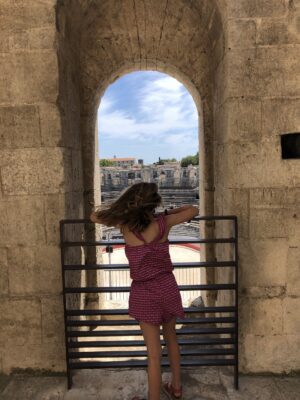
“Stick your head through that wall,” I command a child.
Seems right for this place.
This place is a Roman amphitheater. Site of gladiatorial battles.
This place is Arles, France. Site of Van Gogh’s famous ear amputation.
This place knows how to absorb blood, violence, and spectatorship.
Arles, a small Provencal city, appears in any guidebook to France, but it’s likely ranked behind other “must see” cities like Nice, Avignon, and Aix-en-Provence. I ticked Arles off the list on a third visit to Provence. That delay was misguided. Arles has more (sites) and less (crowds) to offer than the more noted cities.
Our family has opted to explore Arles through a walking tour mash-up of Roman ruins and Vincent Van Gogh sites. An odd combination, yet not at all confusing for my children. They somehow manage to shapeshift as time travelers, apparating on a riverbank captured in Van Gogh’s acrylic swirls and next emerging from a tower of an amphitheater, dizzyingly close to a wall so weary it wants to crumble at the suggestion of supporting a human body.
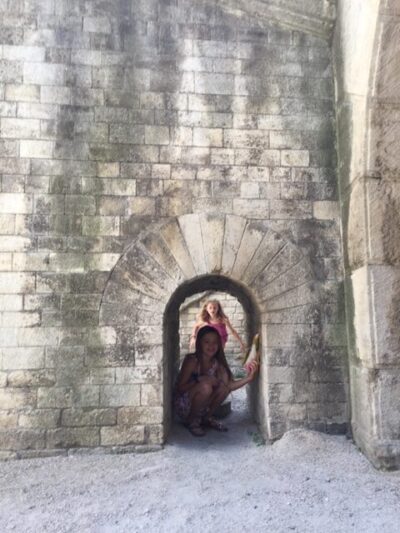
“Stick your duck through that wall, too,” I add. We are “playing” in the Arène d’Arles, the amphitheater in Arles. This Roman marvel dates back to the first century, seats 21,000 gawkers, and was built for chariot races and the bloodiest of combats. Today, modern spectacles of bull fights and concerts still occur here. The Arena is fairly deserted on the day we visit. Among the echoing vaults, we become over-oxygenated, giddy from the switch from hot, modern Provencal streets to the breezes skirting arches. The stones around us are 2,000 years old. I am an infantile 38. Where are we? When are we? Loosed in time, we play.
I tell my kid to stick her head through a hole in a wall for the photo op. That spy hole has framed centuries of sandals, from Franco-Romans to my 2019 Birkenstocks. Some French kid has maybe even held up her stuffed duck for a better view of people bloodying people. I freeze history in the pixels on my phone.
We continue touring Arles with another Roman site, Théâtre Antique d’Arles. Here, the theater’s ancient stones have been reinvigorated, cyborg-like, with steel pillars, stage, and lighting catwalk. The first-century stone seating continues to numb 8,000 bottoms for concerts and plays. We walk out onto the stage, me, my husband, children, and a duck. We bow to the ghostly eyes of centuries of spectators.
I think of 1888, the year Vincent Van Gogh walked the streets of Arles, experiencing these same ruins, sandwiched in time between the gladiators and me. I think of his paintings I’ve seen, surrounded by blank margins on computer screens or book pages, sometimes hanging on museum walls, the paint dried like scabs.
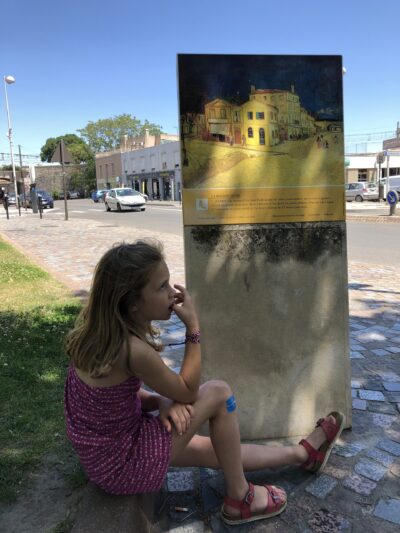
In Arles, we place the guidebook in my 7-year-old’s hands. She has just learned to read with halting fluency. She is a subject-matter expert thanks to a first-grade art unit featuring “Starry Night.” She stops us at various points in the city. We see the broad sweep of a river, once memorialized in “Starry Night Over the Rhône.” We stand on a street corner and learn “This is the site where Van Gogh painted ‘The Yellow House.’ The house in the painting is no longer there. It was bombed in WWII. Today a newsstand and boulangerie stand in its place.”
The man with the famed paintbrush is no longer there either. His lobbed ear (mere words divorced from the violence that surely happened to sever cartilage from scalp) is no longer there. The prostitute to whom he gifted the ear is no longer there. I wonder about that woman. About how bad a day she must have had to be paid in amputated human bits. I wonder how quickly she scrapped the ear in the streets of Arles, one more bloody tidbit offered to a city accustomed to absorbing blood, violence, and spectatorship.
When we arrive at the scene of “Café Terrace at Night” we feel further disillusioned. The café, nearly as memorable a masterpiece as “Starry Night,” is anemic in this square of Arles. Things and people trespass on the scene. Japanese tourists flock under umbrellas. A Peugeot bullies my 10-year-old and her duck who have stepped into the street to squint at the restaurant. The colors are wrong. The café has been repainted the gaudiest shades of yellow and red in an attempt to match the vision Van Gogh had of the Place de Forum when painting by gaslight in chill September nights in 1888.
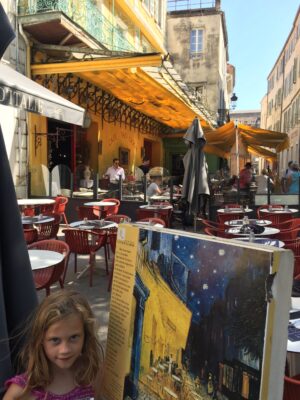
The restaurant is still operational today. Our guidebook informs us, with a spark of snark, that the current management leaves something lacking gastronomically.
We time hop from 1888 to ancient Rome underground: the Cryptoporticus, a titillating name, because Crypt in any language connotes the macabre. The Cryptoporticus are three vaulted underground tunnels forming a “U,” accessed by squeezing down a narrow staircase in the corner of the lobby of the Hotel de Ville. This wormhole of antiquity is positively stuffed with skeletons, according to the imaginations supplied by 7 and 10 year old explorers. Water drips somewhere, a horror movie sound effect. We see zero skulls. The forgotten history down here would be less eerie if we had accidentally kicked a skeleton in the ribs, because at least that guy would have been kindred from more recent times.
At street level, we wrap up our day trip to Arles. We’ve traveled for millennia. We need as much AC as our Renault rental car will blast on our 2019 American bodies. History in Arles is a jarring, bloodstained mash-up, yes, but also an enduring history that can be consumed in the space of a daylight hours’ visit.
But Arles is not about to let us leave without a final bloodbath.
Across Place de la République, we see a flurry of activity. A family of four huddles around a woman on the ground. It’s alarming, this excitement in an otherwise sleepy square. We’re drawn to the spectacle like the professional spectators we’ve practiced to become all day.
We hear some incomprehensible combination of French and garbled syllables of Dutch. The woman on the ground holds her hand to her mouth and blood drips between her fingers. After imagining blood all day, this very real ooze of red startles. The woman’s eyes are unfocused.
We piece together the sudden act of violence that has occurred. This woman, a fellow tourist from the Netherlands or Sweden or maybe Germany, has fallen, hit her mouth, and done what seems to be grave damage to her teeth.
The town square is unaroused by the new spout of blood. No one rushes to help. My group of people stands by impotently, lacking languages in which to offer a doctor, a dentist, or even a tissue. Most of the surrounding stores are closed or are closing. The closest corner store sells gelato and postcards. Bandaids for an arterial wound.
So we gawk as the woman staggers to a doorway and removes her hands. We gasp before she claps her hand back over the space where she once had teeth.
Her teeth are the most recent history we have experienced all day.
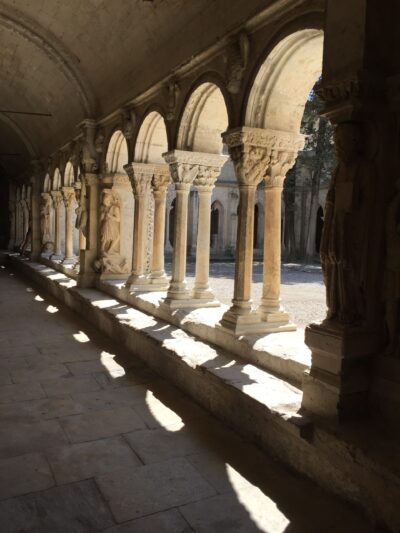
I have one pristine memory of Arles: Le Cloitre Saint-Trophime. The Cloisters are 12th century buildings holding exceptional Provencal Romanesque architecture. The delicate, double-columned arches surrounding an inner courtyard honor bloodless elements of life: contemplation, meditation, patience, self-control, resolve. We walk multiple laps around the courtyard, not once imagining animal or human dismemberment. In a side room I find a stained glass window. The glass is all blue. Not a dab of red. Just cool, translucent blue bathing the floor where sun stains shade.
The Cloisters are the only place in Arles I visit twice. We stopped early in the morning, and again in late afternoon, I seek the blue quiet after witnessing the woman’s bloody mouth. Practically, I take advantage of the closet-sized bathroom. I take more pictures of the arches. We all soak in solace for our battered souls.
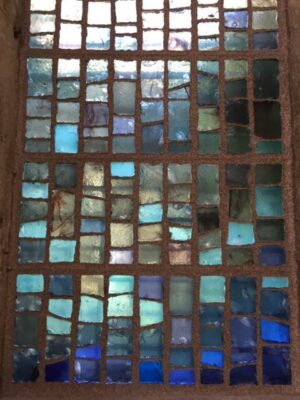
In Arles, the past is fresh. Holes where teeth once were or houses stood or heads poked stand witness to blood rushing in veins or down faces. In Arles, you’ll want to put your head through a wall, kick a skeleton, or wipe blood from a mouth. More than any other city I’ve visited in Provence, Arles offers the opportunity to gawk at the underlying bones and cartilage of history. This place knows how to absorb spectatorship.

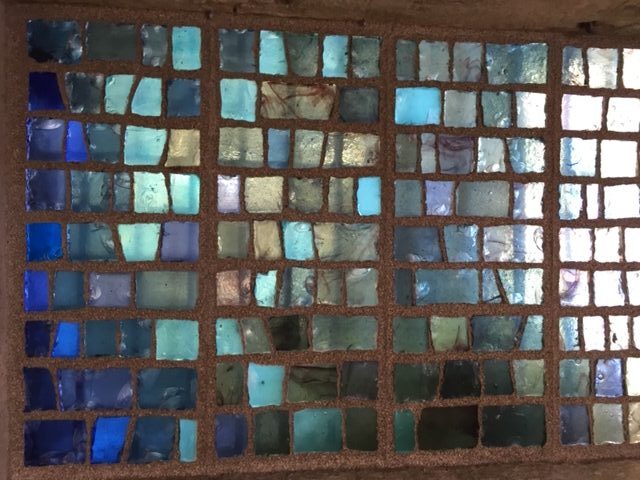
WELCOME BACK PAPERDOLL TALES!! I have missed you. This piece was exquisite, transporting me right there with you.